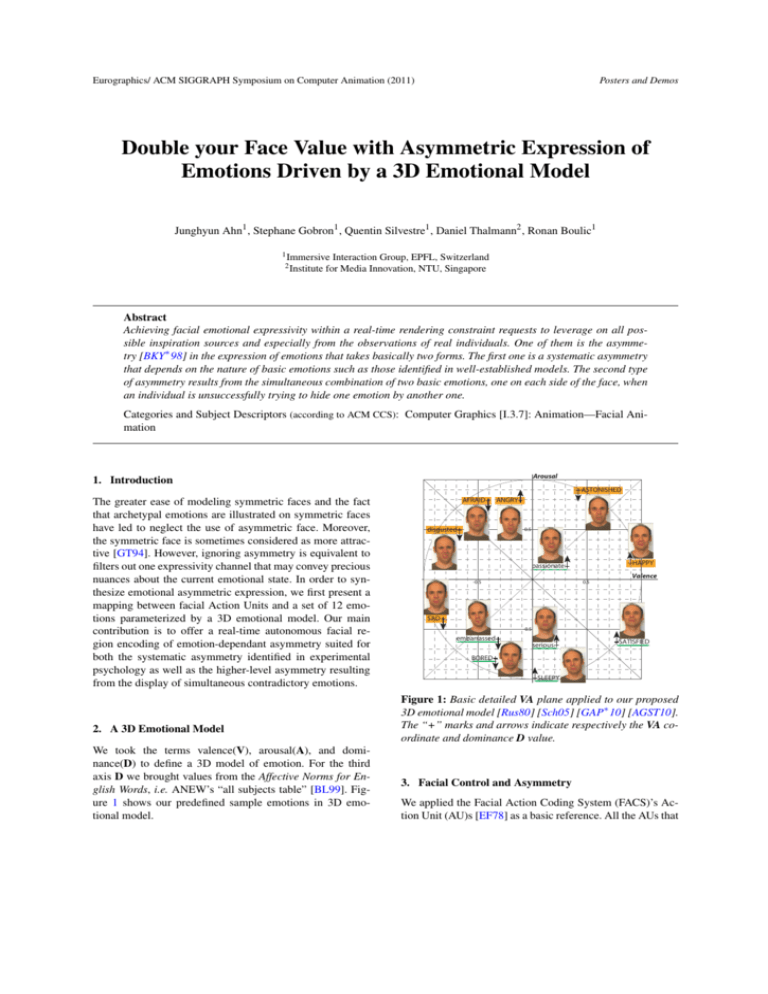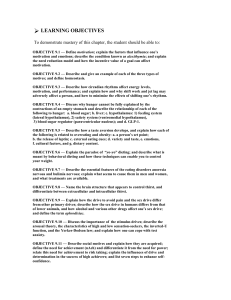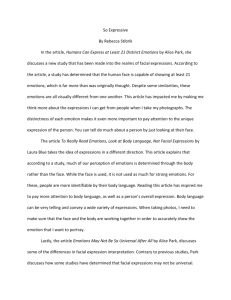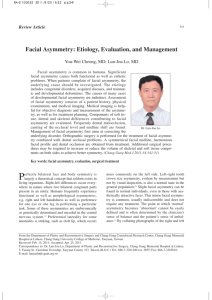Double your Face Value with Asymmetric Expression of Emotions
advertisement

Eurographics/ ACM SIGGRAPH Symposium on Computer Animation (2011)
Posters and Demos
Double your Face Value with Asymmetric Expression of
Emotions Driven by a 3D Emotional Model
Junghyun Ahn1 , Stephane Gobron1 , Quentin Silvestre1 , Daniel Thalmann2 , Ronan Boulic1
1 Immersive
2 Institute
Interaction Group, EPFL, Switzerland
for Media Innovation, NTU, Singapore
Abstract
Achieving facial emotional expressivity within a real-time rendering constraint requests to leverage on all possible inspiration sources and especially from the observations of real individuals. One of them is the asymmetry [BKY∗ 98] in the expression of emotions that takes basically two forms. The first one is a systematic asymmetry
that depends on the nature of basic emotions such as those identified in well-established models. The second type
of asymmetry results from the simultaneous combination of two basic emotions, one on each side of the face, when
an individual is unsuccessfully trying to hide one emotion by another one.
Categories and Subject Descriptors (according to ACM CCS): Computer Graphics [I.3.7]: Animation—Facial Animation
Arousal
1. Introduction
ASTONISHED
The greater ease of modeling symmetric faces and the fact
that archetypal emotions are illustrated on symmetric faces
have led to neglect the use of asymmetric face. Moreover,
the symmetric face is sometimes considered as more attractive [GT94]. However, ignoring asymmetry is equivalent to
filters out one expressivity channel that may convey precious
nuances about the current emotional state. In order to synthesize emotional asymmetric expression, we first present a
mapping between facial Action Units and a set of 12 emotions parameterized by a 3D emotional model. Our main
contribution is to offer a real-time autonomous facial region encoding of emotion-dependant asymmetry suited for
both the systematic asymmetry identified in experimental
psychology as well as the higher-level asymmetry resulting
from the display of simultaneous contradictory emotions.
2. A 3D Emotional Model
We took the terms valence(V), arousal(A), and dominance(D) to define a 3D model of emotion. For the third
axis D we brought values from the Affective Norms for English Words, i.e. ANEW’s “all subjects table” [BL99]. Figure 1 shows our predefined sample emotions in 3D emotional model.
AFRAID
disgusted
ANGRY
0.5
HAPPY
passionate
Valence
-0.5
0.5
SAD
-0.5
embarrassed
serious
SATISFIED
BORED
SLEEPY
Figure 1: Basic detailed VA plane applied to our proposed
3D emotional model [Rus80] [Sch05] [GAP∗ 10] [AGST10].
The “+” marks and arrows indicate respectively the VA coordinate and dominance D value.
3. Facial Control and Asymmetry
We applied the Facial Action Coding System (FACS)’s Action Unit (AU)s [EF78] as a basic reference. All the AUs that
J. Ahn et al. / Double your Face Value with Asymmetric Expression
we considered in our facial control are re-grouped to twelve
AU sets in order to facilitate our parametrization along each
VAD axis. For each AU set, a 21(V)x21(A)x21(D) voxel
space was constructed and the observed value of intensity
(-1, -0.5, 0, +0.5, or +1) was filled in each voxel that correspond to a coordinate of sample emotion. These values are
later used to find face parts’ dependency on emotional axes.
The asymmetric face was derived based on the neuropsychological observations as follows:
Gloom (V=-0.78, A=-0.29, D=-0.36)
• Define a randomize function that gives mostly gives leftbiased facial expression.
• Left-biased effect gives higher probability on the negative
emotion along the V axis.
• Apply observations on the response of facial part muscle
conducted by electromyogram(EMG).
4. Results and Conclusion
We derived two different types of asymmetric expressions.
First, as depicted in Figure 2, we applied {v, a, d} values
of Affective Norm for English Words (ANEW) [BL99] to
our proposed model with asymmetric expression. Second,
we considered the fact that social codes and internal feelings
can lead face to contradictory simultaneous emotions. We
applied two different {v, a, d} coordinate for left and right
face. To the right (i.e. emotions dictate by the social context)
and the left (i.e. emotions driven by the intuitive part of the
brain).
For conclusion, we examined a number of literature surveys on social and neuro psychology for the purpose of
• choosing a suitable 3D emotional model for expressing
emotions with nuances,
• identifying a model of the animation of each facial part as
a function the emotional dimensions, and
• exploiting the effect of emotion in terms of asymmetric
facial expression.
We estimate that the proposed approach will help designers of embodied conversational agents to convey complex
emotions through the added nuances made possible with the
asymmetry model.
Acknowledgements
This research has been funded by a European Union grant,
7th Framework Programme, Theme 3: Science of complex
systems for socially intelligent ICT, which is part of the CYBEREMOTIONS Project (Contract 231323).
References
[AGST10] A HN J., G OBRON S., S ILVESTRE Q., T HALMANN
D.: Asymmetrical facial expressions based on an advanced interpretation of two-dimensional russell’s emotional model. In
ENGAGE 2010 (2010), pp. 1–12. 1
Odd (V=-0.05, A=-0.18, D=-0.06)
Hopeful (V=0.53, A=0.20, D=0.10)
Figure 2: Emotional expressions generated from VAD coordinate (left) and their asymmetric expressions (right).
[BKY∗ 98] B OROD J. C., KOFF E., Y ECKER S., S ANTSCHI C.,
S CHMIDT J. M.: Facial asymmetry during emotional expression:
Gender, valence, and measurement technique. Neuropsychologia
36, 11 (1998), 1209–1215. 1
[BL99] B RADLEY M. M., L ANG P. J.: Affective norms for English words (ANEW): Stimuli, instruction manual and affective
ratings. C-1, University of Florida, Center for Research in Psychophysiology, Gainesville, 1999. 1, 2
[EF78] E KMAN P., F RIESEN W. V.: Facial action coding system.
CA: Consulting Psychologists Press (1978). 1
[GAP∗ 10] G OBRON S., A HN J., PALTOGLOU G., T HELWALL
M., T HALMANN D.: From sentence to emotion: a real-time
three-dimensional graphics metaphor of emotions extracted from
text. The Visual Computer 26, 6-8 (June 2010), 505–519. 1
[GT94] G RAMMER K., T HORNHILL R.: Human (Homo sapiens) facial attractiveness and sexual selection: The role of symmetry and averageness. Journal of Comparative Psychology 108,
3 (1994), 233–242. 1
[Rus80] RUSSELL J. A.: A circumplex model of affect. Journal
of Personality and Social Psychology 39, 6 (1980), 1161–1178.
1
[Sch05] S CHERER K. R.: What are emotions? and how can they
be measured? Social Science Information 44, 4 (2005), 695–729.
1








